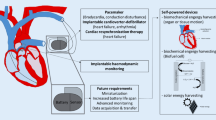Abstract
For any implantable device size and efficiency are critical properties. Thus, a linear motor for a Total Artificial Heart was optimized with focus on driver electronics and control strategies. Hardware requirements were defined from power supply and motor setup. Four full bridges were chosen for the power electronics. Shunt resistors were set up for current measurement. Unipolar and bipolar switching for power electronics control were compared regarding current ripple and power losses. Here, unipolar switching showed smaller current ripple and required less power to create the necessary motor forces. Based on calculations for minimal power losses Lorentz force was distributed to the actor’s four coils. The distribution was determined as ratio of effective magnetic flux through each coil, which was captured by a force test rig. Static and dynamic measurements under physiological conditions analyzed interaction of control and hardware and all efficiencies were over 89%. In conclusion, the designed electronics, optimized control strategy and applied current distribution create the required motor force and perform optimal under physiological conditions. The developed driver electronics and control offer optimized size and efficiency for any implantable or portable device with multiple independent motor coils.

ᅟ
















Similar content being viewed by others
References
Cuenca-Navalon E, Finocchiaro T, Laumen M, Fritschi A, Schmitz-Rode T, Steinseifer U (2014) Design and evaluation of a hybrid mock circulatory loop for total artificial heart testing. Int J Artif Organs 1(37):71–80. https://doi.org/10.5301/ijao.5000301
Demondion P, Fournel L, Niculescu M, Pavie A, Leprince P (2013) The challenge of home discharge with a total artificial heart: the La PitieSalpetriere experience. Eur J Cardiothorac Surg 44(5):843–848. https://doi.org/10.1093/ejcts/ezt146
Eurotransplant International Foundation (2016) Eurotransplant Statistics - 2015. Eurotransplant International Foundation. Leiden, Netherlands. Available via DIALOG: http://www.eurotransplant.org/cms/mediaobject.php?file=AR_ET_20153.pdf. Accessed 20 Dec 2016
Finocchiaro T, Butschen T, Kwant P, Steinseifer U, Schmitz-Rode T, Hameyer K, Lessmann M (2008) New linear motor concepts for artificial hearts. IEEE Trans Magn 44(6):678–681. https://doi.org/10.1109/TMAG.2007.916110
Fritschi A, Laumen M, Spiliopoulos S, Finocchiaro T, Egger C, Schmitz-Rode T, Tenderich G, Koerfer R, Steinseifer U (2013) Image based evaluation of mediastinal constraints for the development of a pulsatile total artificial heart. Biomed Eng Online 12(1):12. https://doi.org/10.1186/1475-925X-12-81
Gerosa G, Scuri S, Iop L, Torregrossa G (2014) Present and future perspectives on total artificial hearts. Ann Cardiothorac Surg 3(6):595–602. https://doi.org/10.3978/j.issn.2225-319X.2014.09.05
Guo J, Ge H, Ye J, Emadi A (2015) Improved method for MOSFET voltage rise-time and fall-time estimation in inverter switching loss calculation. Transportation Electrification Conference and Expo, Dearborn. https://doi.org/10.1109/ITEC.2015.7165790
Ohm D, Oleksuk R (2002) Influence of PWM schemes and commutation methods for DC and brushless motors and drives. P.E. Technology Conference, Rosemont
Pelletier B, Blaszczyk Y, Carstens P, Alvarez G, Lamping F, Laumen M, Finocchiaro T, Steinseifer U (2016) Novel optical position sensing for miniaturized applications and validation in a total artificial heart. IEEE Trans Biomed Eng 63(3):478–484. https://doi.org/10.1109/TBME.2015.2463729
Pelletier B, Spiliopoulos S, Finocchiaro T, Graef F, Kuipers K, Laumen M, Guersoy D, Steinseifer U, Koerfer R, Tenderich G (2014) System overview of the fully implantable destination therapy—ReinHeart-total artificial heart. Eur J Cardiothorac Surg 47(1):80–86. https://doi.org/10.1093/ejcts/ezu321
Rashid M (2011) Inverters in power electronics handbook, 3rd edn. Elsevier, Amsterdam, pp 363–364
Unthan K, Gräf F, Laumen M, Finocchiaro T, Sommer C, Lanmüller H, Steinseifer U (2015) Design and evaluation of a fully implantable control unit for blood pumps. BioMed Res Int 2015:9 pages. doi: https://doi.org/10.1155/2015/257848. Available: https://www.hindawi.com/journals/bmri/2015/257848/abs/
World Health Organization (2014) The top 10 causes of death. World Health Organization, Geneva, Switzerland. Available via DIALOG: http://www.who.int/mediacentre/factsheets/fs310/en/. Accessed 20 Dec 2016
Acknowledgements
The ReinHeart was developed in cooperation with MecoraMedizintechnik GmbH (Aachen, Germany) in a research project funded by the European Union and the state of North Rhine-Westphalia and the Erich und Hanna Klessmann Stiftung (Grant ID: 005-GW01-206B).
Author information
Authors and Affiliations
Corresponding author
Rights and permissions
About this article
Cite this article
Unthan, K., Cuenca-Navalon, E., Pelletier, B. et al. Driver electronics design and control for a total artificial heart linear motor. Med Biol Eng Comput 56, 1487–1498 (2018). https://doi.org/10.1007/s11517-018-1790-7
Received:
Accepted:
Published:
Issue Date:
DOI: https://doi.org/10.1007/s11517-018-1790-7




